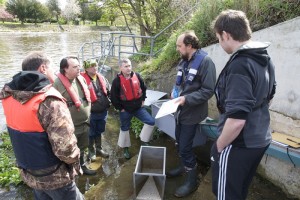Thames Anglers’ Conservancy joins important eel monitoring programme
Thames Anglers' Conservancy joins important eel monitoring programme
 The Thames Anglers' Conservancy in partnership with the Zoological Society for London has taken on the monitoring of the newly installed eel trap at Molesey weir.Ten volunteers from the TAC have received training in how to record any eels that are caught in the trap during the migratory season.
The Thames Anglers' Conservancy in partnership with the Zoological Society for London has taken on the monitoring of the newly installed eel trap at Molesey weir.Ten volunteers from the TAC have received training in how to record any eels that are caught in the trap during the migratory season.
ZSL training volunteers at Molesey Weir
Research over the last 30 years has shown that the European eel (Anguilla anguilla) is facing a range of threats that are severely impacting on their recruitment – and potentially their populations in freshwater – leading to its 2008 Critically Endangered classification in the International Union for Conservation of Nature’s Red List of Threatened Species. The number of young eels joining the resident adult population across European catchments is believed to have declined by up to 95% since the early 1980s.
In 2005, in response to this alarming decline, the Zoological society of London set up its Eel Monitoring Programme.
Joe Pecorelli of the Zoological Society for London said: “Thanks to the help of partnership organisations such as the Thames Anglers' Conservancy we now have 12 monitoring sites in Greater London all contributing to this unique and important study. The information we get feeds into the eel management plan for the River Thames and allows us to make evidence based conservation decisions”.
“The European eel has one of the most fascinating of all animal life-cycles. Beginning life as leaf-shaped larvae known as a ‘leptocephalus’ in the Sargasso Sea, they make an incredible migration across the Atlantic Ocean to the rivers and shallow coastal waters of Europe”.
Joe added: “We are delighted that the Thames Anglers' Conservancy has agreed to take on the monitoring at Molesey Weir and we hope this will be the start of a very productive partnership between our organisations."
Dave Harvey Chairman of the TAC said “Thames eels face many challenges getting this far up the river including trying to navigate their way through the millions of tonnes of sewage entering the Thames Tideway each year. Molesey Weir is significant, as it is the first barrier on the non-tidal Thames, so we are looking forward to see how the monitoring progresses. As anglers we are acutely aware of how important this conservation programme is and we are delighted to have the opportunity to assist in partnership with the ZSL.
More information on the Zoological Society of London’s work with European eels, within the River Thames and abroad please visit the ZSL website and the Marine & Freshwater team’s facebook page:
This entry was posted in
News and tagged
Eels,
Fish,
TAC,
ZSL. Bookmark the
permalink.


